Last weekend I visited one of my favorite collecting spots in all of Missouri—Long Bald Glade Natural Area (part of Caney Mountain Conservation Area in Ozark Co.). Nestled at the eastern edge of the White River Hills in southwestern Missouri, its deeply dissected hills are home to numerous plants and animals that are more typical of the southern Great Plains and which have found refuge in the xeric, thin-soiled calcareous prairies (commonly “cedar glades”) that cover the area’s southern- and western-facing slopes. These include some rather impressive insects, such as a disjunct population of Cicindelidia obsoleta vulturina, which I just found here last year as the new northeasternmost extent of the population, as well as the marvelously monstrous Microstylum morosum, North America’s largest robber fly and so far known in Missouri only from Long Bald Glade where it was discovered in 2009.
Another quite striking insect found at Long Bald Glades (though not restricted in Missouri to the White River Hills) is the bumelia borer, Plinthocoelium suaveolens. This beetle occupied much of my time in July 2009 as I committed to photographing the species in the wild, and it was Long Bald Glade where I finally (if not completely satisfactorily) succeeded in that goal. This time I was visiting the Glade to look for the earliest individuals of C. obsoleta vulturina and, hopefully, document additional glades within Caney Mountain that might support the beetle. However, in the back of my mind I was also keeping a lookout for P. suaveolens—this species is primarily active during July and August in Missouri, but I do have records of it as late as September. As I looked for (and found) tiger beetles, I also checked out each bumelia tree that I passed hoping to see a P. suaveolens adult perched on its lower trunk. It was not until later in the afternoon that I heard a loud “buzz” approaching from behind and turned to see one of these beauties fly right past me—legs and antennae held outstretched—before landing on a nearby tree. Now, over the years I’ve learned a few lessons, and one is that you don’t try to take in situ photographs of the first individual you encounter of a prized species. More often than not it gets away before you even fire the first shot, and you’re left with nothing. My standard procedure now is to procure the first individual immediately and keep it alive. If attempts to photograph subsequent individuals are not successful (or none are seen), then at least I have a backup for studio shots (not my first choice, but better than nothing!). Such was the case with this individual.
Although I still lack that “perfect” beetle-on-a-branch shot that I hope to eventually get for this species, it seemed a good subject for some white-box photography. I’ve vacilated between true white-box w/ indirect flash versus getting a white-box effect by using direct, diffused flash with the subject on a white background. I decided now was the time for a direct comparison of the two techniques. All of the following photographs were taken with the Canon 100mm macro lens on a Canon 50D body at 160 ISO, 1/200 sec, and f/16. For the closeups (photos 3 and 5 of each series), 68mm of extension tubes were added. The photos on the left are true white-box photos, i.e. the flash heads were directed up and away from the subject placed inside a box lined with white tissue (Kim-Wipes laboratory wipers). The photos on the right mimic the white-box effect by placing the subject on white filter paper, but the flash heads were pointed directly at the subject through my DIY concave diffuser (click on photos for 1200×800 versions):
I must admit, looking at the photos on the camera playback screen I had the impression that I would like the direct-diffuser photos better, but after reviewing them on the computer and applying typical post-processing enhancements (e.g., levels, slight shadow reduction, and unsharp mask), the true white-box photos appear to have benefited from more even lighting, resulting in truer color, less shadowing, and minimal specular highlighting. Not that the direct-diffuser photos are bad—they’re just not as good as the white-box photos. I guess what this means is that my DIY diffuser, while a significant improvement over my previous diffusers, still could use some improvement (if ability to create white-box-like results is the ultimate test of a diffuser’s effectiveness). I’d be interested in knowing your opinions based on these comparisons.
Congratulations to Ben Coulter, who wins yet another Super Crop Challenge and strengthens his lead in the overall standings of the current BitB Challenge Session #4 with 13 points. Mr. Phidippus also correctly identified the species and takes 2nd place in the challenge with 8 points, keeping him in 2nd place in the overall standings as well. Morgan Jackson takes 3rd place in the challenge with 7 points, but Roy’s retains 3rd place in the overall standings by way of his 6 points in this challenge. Congratulations to these top points earners, and thanks to all who played.
Copyright © Ted C. MacRae 2011
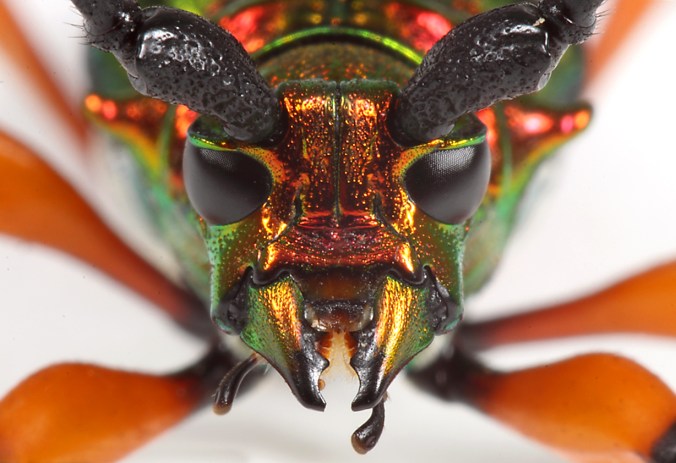


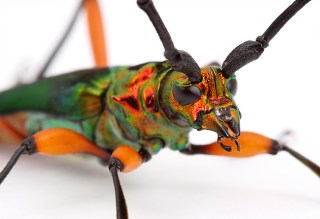



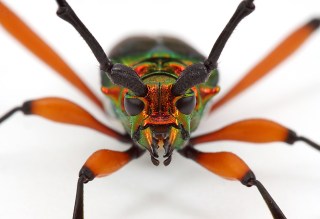
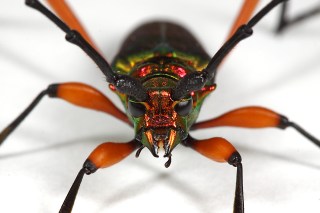
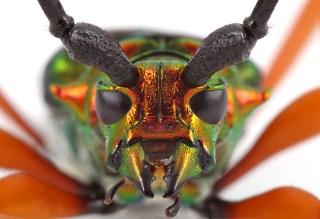

Beautiful shots and beast Ted! Did you take any images “in the wild?” If so, we need to talk!
I have field shots in my previous post about this beetle: North America’s most beautiful longhorned beetle.
Thanks! I would like to use one of these for my new field guide on eastern beetles. I will send off a “formal” request via email soon.
Cool – thanks!
I too thought the white box photos were better except for the middle row. In that set the DIY diffuser seemed better. Don’t know if it had to do with the angle or what but there seems to be more light and better color. I t appears as if the DOF might be a little deeper in the direct flash shots too and maybe that is why the color looks better in the middle row.
Hi JK. In the middle row the reds do look a little more intense, but this seems to come at the expense of the greens which are somewhat blacked out in the shadowed areas. DOF should be the same as all shots were taken at f/16 and had the same settings used in unsharp mask. I think you’re right about slight differences in the angle, which in this species has a big impact on how the color looks.
I definitely prefer the whitebox versions with less distinct shadows. They seem to have more “pop”.
As an aside, I wanted to join in the challenge, but it’s sometimes difficult to find time during the week. I had hoped you’d wait to reveal the answer till later in the weekend. Totally up to you of course, but you might consider leaving late week challenges open a bit longer. Then again, I suppose I’m being selfish because now I’m asking you to give up part of your weekend to analyze and post the results. Oh well, just something to think about.
Hi Troy – sorry, I would have greatly welcomed your participation. Please feel free to let me know via comment (since they’re moderated anyway) if you plan to play but need a little time – I’m not on any schedule. 🙂 (Well, actually I am, but the blog happens on the fly!)
I just can’t stop staring at the rich colors. What an awesome beetle!
Indeed – it’s why I called it North America’s most beautiful longhorned beetle!
Stunning shots Ted! I wouldn’t want to see any more diffusion than you see in your white-box photos. Personally I like to see some highlighting in the eyes, and some shadow–it helps ‘ground’ the subject without making it look like its suspended in air.
Hi Adrian – thank you! I agree about the need for some highlighting and shadowing – eliminate it all and you have the flat ring-flash effect.
If only I could get that white box level of diffusion out in the field – without carrying a white box around!
Hi Ted, amazing shot. Did you use your new lighting system to capture all of the beautiful colors?
These were all taken using my MT-24EX, but the difference in those taken in the white box is that I had the flash heads mounted on Kaiser shoes. This gives me much more flexibility in how I direct the flash heads compared to direct mounting on the flash bracket – I had both of them pointed towards the upper sides so that bounce was directed at the beetle. This gave better illumination than previous attempts.
I still think a speedlight sitting at the side (or two speedlights on each side) directed upward and slightly forward will give the best illumination, but until I can get one (or two) of those units this is the best I can do (though it’s not bad).
Pingback: Two things I love about glades during fall… « Beetles In The Bush
Pingback: Not an emerald ash borer — but what is it? | Millard Fillmore's Bathtub
Found one of these beauties in my backyard in Sw Florida today. Heard the buzz and saw it land on a weedy bush. Got some good plant walking shots
Got somewhere I can send u a copy?
Pingback: Another look at North America’s most beautiful longhorned beetle | Beetles In The Bush
Pingback: Bumelia Borer, Plinthocoelium suaveolens | Wildlife Wednesday – Oceanic Wilderness